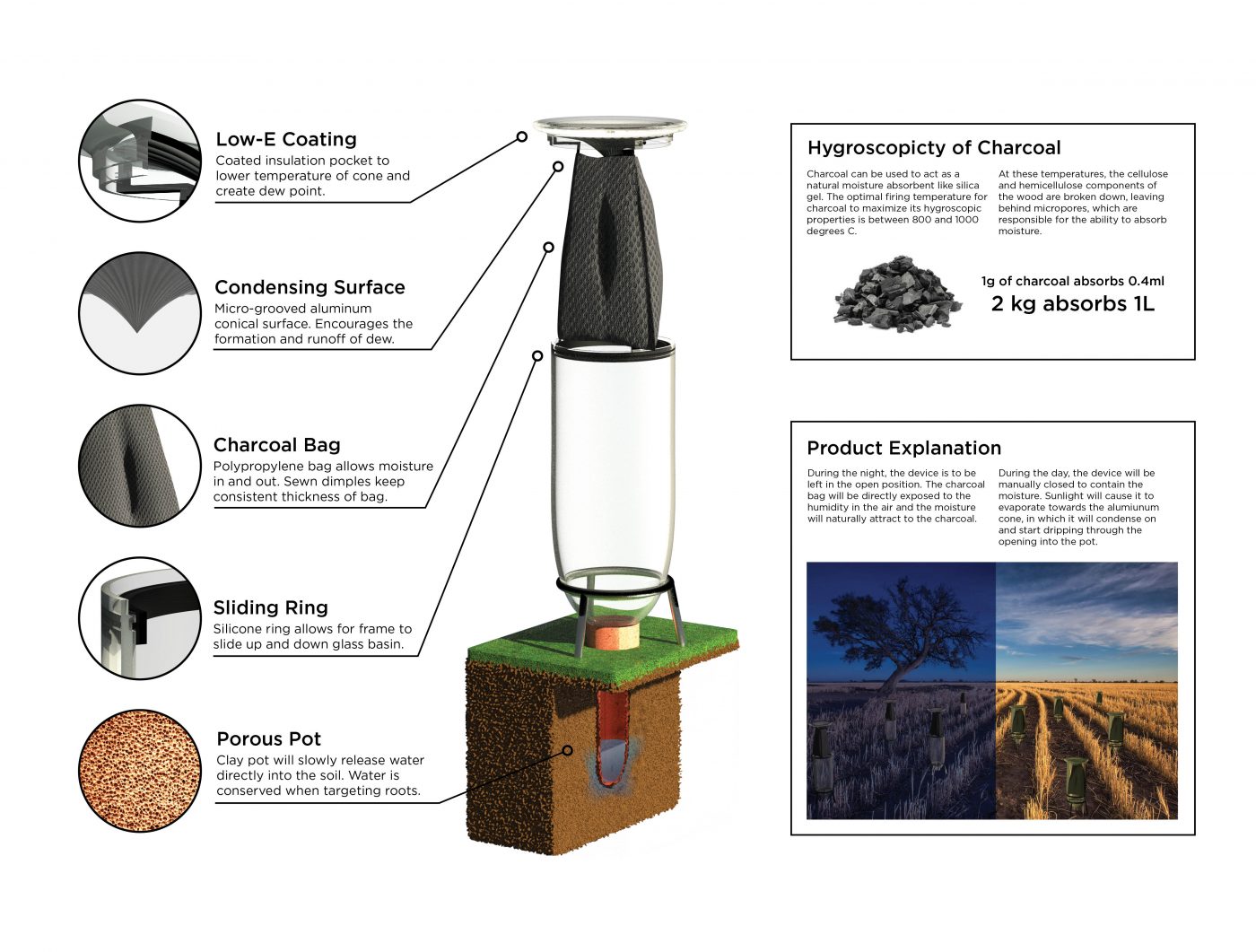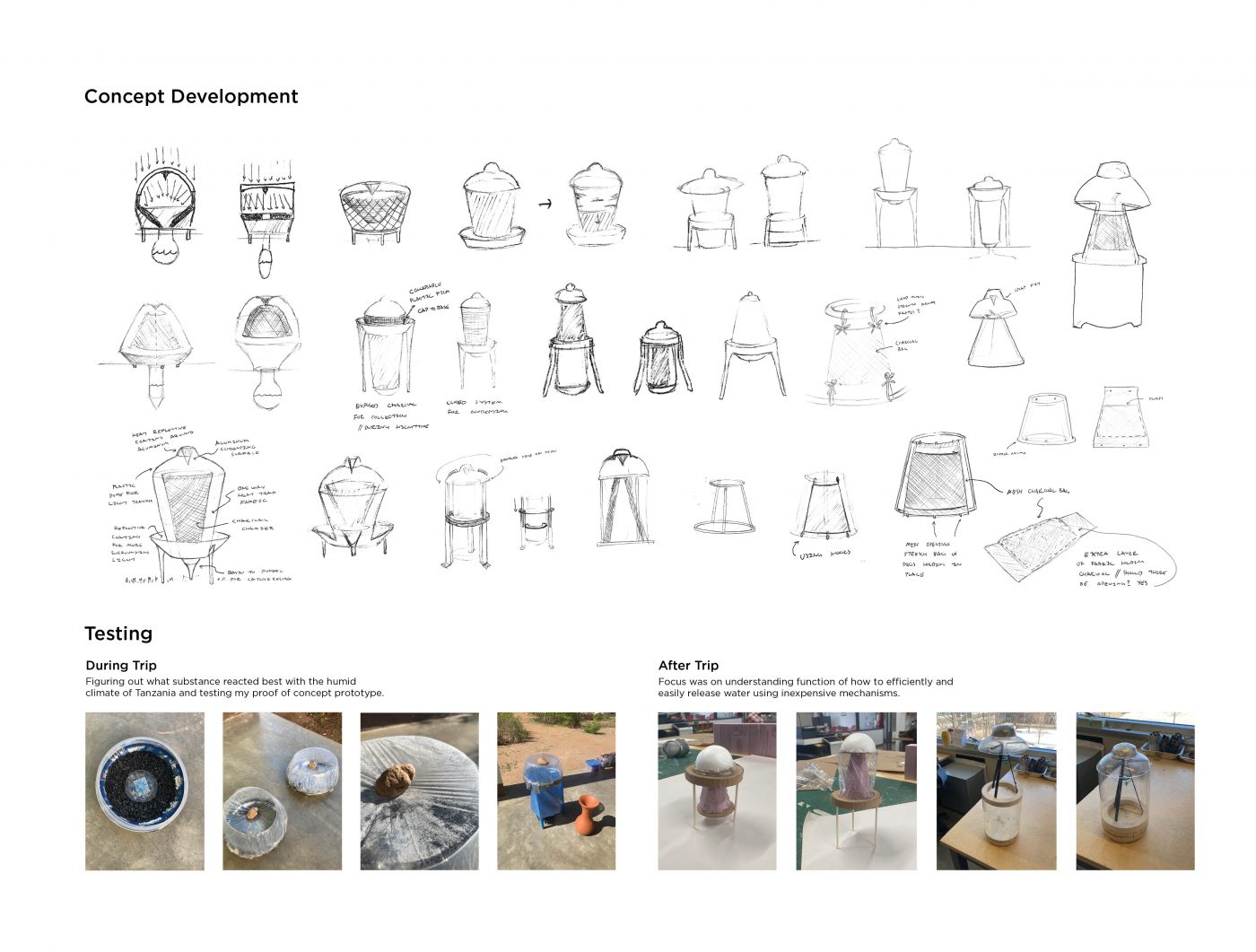
Kaleb Aman’s capstone project, Dewpointe, was the Canadian National winner of the James Dyson Award. Kaleb was selected from 30 inspiring entries and will now move on to the international competition. The International winner and sustainability winner will be announced on November 15, 2023.
DEWPOINTE
DewPointe is a sustainable irrigation system that uses collected atmospheric moisture and bottom-up watering techniques. This system attracts moisture from the atmosphere with the hygroscopic properties of charcoal and turns that moisture into water for crops. It targets the lack of readily available water and encourages smallholder farmers to cultivate while keeping costs low.
INSPIRATION |
The current dry spell in the Longido District of Tanzania has hindered many smallholder farmers from efficiently cultivating crops year round. With the limited water supply, the priority of expensive tap water is always drinking water and sustaining livestock. This unfortunately leads to agriculture being overlooked. I wanted to create a solution that would encourage crop production year round through a low cost, passive irrigation system. It was important to provide a solution that fits the needs and the lifestyle patterns of the Longido people while aiming to encourage food security and create revenue in crop yield while conserving water. |
HOW IT WORKS |
The Longido District falls within a climate with a high humidity index of about 80%. With the available moisture in the atmosphere, my project aims to harness that moisture and use it to water crops. The element that is responsible for this is charcoal for its hygroscopic properties. My testing has revealed that 2 kg of this treated charcoal can absorb 1L of water during a 10 hour period at 80% humidity. The charcoal pellets would be placed in a breathable bag to allow moisture to pass through. During the night, the charcoal will be exposed to humidity and the moisture will naturally attract to the charcoal. During the day, charcoal will be enclosed and sunlight will cause trapped moisture to evaporate and condense. The microgroove surface that water will condense on will direct dripping of water and target the crops roots for efficient water use. One system can sustain crops within a radius of 1m therefore, they would be carefully positioned in the field. |

DESIGN PROCESS |
Initially, I investigated dew harvesting to see if condensation and form and runoff to water crops passively but then learned the temperature at night does not drop enough to create the dew point for moisture to condense. This swayed me to look into materials that could absorb moisture in the atmosphere and release that moisture when exposed to heat. Before Tanzania, I got to test silica gel, charcoal and salt for their hygroscopic properties. During the trip, I had the chance to test my concept in the dry climate. A few hours after sunrise, the heat released the collected moisture out of the subjects and water condensed on the inside of the container. Charcoal was revealed to have the best results. Proof of concept. Upon returning, I did more investigation as to how I could increase the yield ratio. I simulated tests of bags of charcoal at different thicknesses, size of pellets, and material of the bag. I then prototyped different mechanisms for the transition of the charcoal in its exposed and closed positions. The frame would slide up and down a glass basin with a rubber ring around the frame. After user testing, the form of the handle was finalized and it was time to bring the components together visually, a form that would seamlessly transition the system into the ground. |

HOW IT IS DIFFERENT |
The existing industry focus on water-from-air is biased towards creating solutions that are relatively complicated and expensive drinking water systems. Drinking water usually requires a much larger yield and different levels of filtration which increase cost. Water-from-air for horticulture is an important niche which has been neglected. There is no need for purification. This system properly accommodates this certain climate and life pattern which is the reason for the low tech solution that is also environmentally friendly. All aspects of this design use found and recyclable materials while aiming to encourage food security. There are no mechanical components which lower the cost and it is a very easy to use system that requires little user interaction and maintenance. With the success of this system, farmers can now be encouraged to grow during the drier spells and have larger crop yields which in turn can lead to more food and income for the community. |

FUTURE PLANS |
The future development of this project will rely on field testing to fully understand yield. I am working alongside controlled greenhouses to test in a more appropriate climate. I have been in contact with a Physical Geographer specializing in atmospheric water who is assisting me with guiding the project’s potential. Upon results, another phase of user testing and a manufacturing analysis will be done to streamline to maximize output per system. It is also important to keep manufacturing and production local. With refinements, the concept will be presented to NGOs hopefully leading to funding and implementation of this system. |